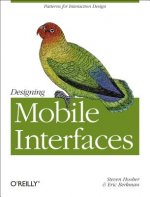
Code: 04834993
Supporting and Exploiting Spatial Memory in User Interfaces
by Carl Gutwin, Andy Cockburn, Joey Scarr
Spatial memory is an important facet of human cognition - it allows users to learn the locations of items over time and retrieve them with little effort. In human-computer interfaces, a strong knowledge of the spatial location of ... more
- Language:
 English
English - Binding: Paperback
- Number of pages: 100
Publisher: now publishers Inc, 2013
- More about this

You might also like
-

CISSP (R) Study Guide
66.31 € -1 % -

How to Be a Movie Star: Elizabeth Taylor in Hollywood
12.47 € -4 % -

China's Security State
111.19 € -

Simple Views On Condensed Matter (Third Edition)
231.96 € -

Film Stars Don't Die in Liverpool: A True Love Story
15.39 € -19 % -

Evolution of College English
62.18 € -

Das MoPeG in der Notar- und Gestaltungspraxis
112.70 € -2 %
Give this book as a present today
- Order book and choose Gift Order.
- We will send you book gift voucher at once. You can give it out to anyone.
- Book will be send to donee, nothing more to care about.
More about Supporting and Exploiting Spatial Memory in User Interfaces
You get 181 loyalty points
 Book synopsis
Book synopsis
Spatial memory is an important facet of human cognition - it allows users to learn the locations of items over time and retrieve them with little effort. In human-computer interfaces, a strong knowledge of the spatial location of controls can enable a user to interact fluidly and efficiently, without needing to visually search for relevant controls. Computer interfaces should therefore be designed to provide support for developing the user's spatial memory, and they should allow the user to exploit it for rapid interaction whenever possible. However, existing systems offer varying support for spatial memory. Many modern interfaces break the user's ability to remember spatial locations, by moving or re-arranging items; others leave spatial memory underutilised, requiring slow sequences of mechanical actions to select items rather than exploiting users' strong ability to index items and controls by their on-screen locations. Supporting and Exploiting Spatial Memory in User Interfaces highlights the importance of designing for spatial memory in HCI. It summarises empirical results on spatial memory from both the psychology and HCI domains, identifying a set of observable properties of spatial memory that can be used to inform design. It also analyses existing interfaces in the HCI literature that support or disrupt spatial memory, including space-multiplexed displays for command and navigation interfaces, different techniques for dealing with large spatial data sets, and the effects of spatial distortion. Supporting and Exploiting Spatial Memory in User Interfaces provides strong evidence that spatial knowledge of controls and data enables rapid interaction and information retrieval, and allows users to focus more of their cognitive resources on the task at hand, rather than on the interface. It is aimed at user interface designers, as well as other HCI researchers interested in spatial memory. Useful guidelines for designers are identified throughout the book, which provide clear advice on how and when to design with spatial memory in mind. Similarly, the concluding summary of the area, as well as methodological cautions and directions for future research provide an excellent resource for scientists interested in the importance of spatial memory in user interfaces.
 Book details
Book details
Book category Books in English Computing & information technology Computer science Human-computer interaction
71.84 €
- Full title: Supporting and Exploiting Spatial Memory in User Interfaces
- Author: Carl Gutwin, Andy Cockburn, Joey Scarr
- Language:
 English
English - Binding: Paperback
- Number of pages: 100
- EAN: 9781601987464
- ISBN: 1601987463
- ID: 04834993
- Publisher: now publishers Inc
- Weight: 154 g
- Dimensions: 234 × 156 × 5 mm
- Date of publishing: 05. December 2013
Trending among others
-

Don't Make Me Think, Revisited
40.75 € -10 % -

This is Service Design Doing
50.01 € -

Quantifying the User Experience
47.59 € -11 % -

Practical UX Design
45.68 € -

Microinteractions: Full Color Edition
30.38 € -24 % -

Interview Techniques for UX Practitioners
25.75 € -

Mobile Design Pattern Gallery 2e
44.57 € -19 % -

Accessibility Handbook
22.13 € -

Hands-On Data Analysis with NumPy and pandas
32.60 € -

Fixing Bad UX Designs
45.68 € -

SAP on the Cloud
61.28 € -

About Face - The Essentials of Interaction Design, 4e
53.33 € -11 % -

Rocket Surgery Made Easy
35.01 € -22 % -

UX Strategy
42.46 € -15 % -

Practical Tableau
65.81 € -1 % -

UX Book
85.33 € -1 % -

Mapping Experiences
46.18 € -17 % -

Bottlenecks
36.72 € -19 % -

Calm Technology
19.11 € -26 % -

UI UX Design
70.13 € -

Evil by Design - Interaction design to lead us into temptation
30.28 € -28 % -

Information Architecture, 4e
55.04 € -15 % -

Art of Borderlands 3
44.57 € -4 % -

Information Visualization
72.05 € -8 % -

Cognitive Biases in Visualizations
130.11 € -16 % -

Interaction Design: Beyond Human-Computer Interaction, Fifth Edition
85.73 € -

Designing with Data
35.62 € -29 % -

Complex Network Analysis in Python
29.07 € -28 % -

Tao of Microservices
55.74 € -

Forms that Work
56.65 € -4 % -

Designed for Use 2e
39.54 € -

Neural Circuits and Networks, 1
120.75 € -

Mobile User Experience
46.48 € -4 % -

Software Testing in the Cloud
64.30 € -

OPC Unified Architecture
79.59 € -4 % -

Introduction to Parallel Processing
239.91 € -

SAP on the Cloud
61.28 € -

Microsoft Power BI Cookbook
68.22 € -

Bootstrap
20.62 € -1 % -

Researching UX: User Research
33.90 € -4 % -

Designing Mobile Interfaces
40.65 € -19 % -

Universal UX Design
72.55 € -

Simple and Usable Web, Mobile, and Interaction Design
36.72 € -9 % -

Artificial Intelligence and Games
36.52 € -12 % -

Interactive Data Visualization for the Web
52.32 € -14 % -

Augmented Reality in public spaces. Basic Techniques for video mapping
46.18 € -

Human-Computer Interaction
106.26 € -

Introducing Ethereum and Solidity
66.61 € -12 % -

UX for the Web
45.68 €
Collection points Bratislava a 2642 dalších
Copyright ©2008-24 najlacnejsie-knihy.sk All rights reservedPrivacyCookies



 15549 collection points
15549 collection points Delivery 2.99 €
Delivery 2.99 € 02/210 210 99 (8-15.30h)
02/210 210 99 (8-15.30h)